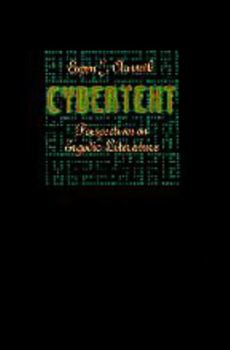Cybertext: Perspectives on Ergodic Literature
Select Format
Select Condition 
Book Overview
Can computer games be great literature? Do the rapidly evolving and culturally expanding genres of digital literature mean that the narrative mode of discourse-novels, films, television series-is losing its dominant position in our culture? Is it necessary to define a new aesthetics of cyborg textuality? In Cybertext, Espen Aarseth explores the aesthetics and textual dynamics of digital literature and its diverse genres, including hypertext fiction, computer games, computer-generated poetry and prose, and collaborative Internet texts such as MUDs. Instead of insisting on the uniqueness and newness of electronic writing and interactive fiction, however, Aarseth situates these literary forms within the tradition of "ergodic" literature-a term borrowed from physics to describe open, dynamic texts such as the I Ching or Apollinaire's calligrams, with which the reader must perform specific actions to generate a literary sequence. Constructing a theoretical model that describes how new electronic forms build on this tradition, Aarseth bridges the widely assumed divide between paper texts and electronic texts. He then uses the perspective of ergodic aesthetics to reexamine literary theories of narrative, semiotics, and rhetoric and to explore the implications of applying these theories to materials for which they were not intended.
Format:Paperback
Language:English
ISBN:0801855799
ISBN13:9780801855795
Release Date:September 1997
Publisher:Johns Hopkins University Press
Length:216 Pages
Weight:0.60 lbs.
Dimensions:0.5" x 5.5" x 8.6"
Age Range:18 years and up
Grade Range:Postsecondary and higher
Customer Reviews
3 ratings
A fascinating subject
Published by Thriftbooks.com User , 19 years ago
The word `ergodic' is very familiar in mathematics and physics, where in the former it designates measure-preserving transformations and in the latter an equivalence between time and space averages. To see the term appear in literary analysis is therefore interesting, and instigates curiosity as to its role there. The author of this book is the first one to refer to `ergodic literature' and he therefore gives the reader insight into the subject that perhaps cannot be obtained anywhere else. As a whole the book is very interesting, even though at times it might appear that the author is skating to close to the `deconstructive' school of literary criticism. When one reads a book in the "normal" way one stares at the cover, reads the title, opens the book, and then begins reading at the first page and continues reading until the book is finished. The content of the book usually does not require the reader to perform any particular actions other the mere act of turning the pages and reading. But in the Internet age it is clear that texts or books (i.e. "hypertext") can require that the reader become more "active". For example, the reader may have to click on hyperlinks, input words or information to the story or text, or even interact with story by using user interfaces so that the story can take on a different path or even have a different ending. To require the `reader' to become actively involved is the key strategy of ergodic literature. As the author states, a `nontrivial' effort is required by the reader to get through an ergodic text. This is to be contrasted with a nonergodic literature where no such effort is needed. In ergodic literature, something else must be occurring outside the confines of the thought processes of the reader. This is what the author refers to as the `extranoematic' responsibilities on the part of readers when they `interact' with ergodic literature. So other than `hypertext', are there any other examples of ergodic literature in history? Interestingly, the author points to the ancient Chinese text I Ching, The Book of Changes, as an example, due to the use of randomization to combine the texts of the `hexagrams.' The author gives a few other examples, all of them of which should be familiar to the experienced reader. All of these examples require that the `reader' participate in some way with the text or the play. For one example, the result of court trial is dependent on the `vote' of the reader. Of course, this book itself is not an example of ergodic literature since it presents a case for it in an organized `linear' fashion, and readers must respect this linear order if they are to fathom the arguments of words of the author. However when reading the book one can see the value and challenge of ergodic literature. A computer game for example, could be viewed as a full-fledged novel. Literary purists may be cringe at this prospect, but to this reviewer it signifies a fascinating development, and one that coul
Just get it
Published by Thriftbooks.com User , 25 years ago
... what else is necessary to say. This book will spur so many thoughts and ideas that you will be reading it for ever after. It is a must for any serious hypertext/cybertext scholar.
THE book on interactive narrative studies
Published by Thriftbooks.com User , 27 years ago
Aristotle is alive and he is norwegian! Finally here is the lost book of Poetics. If you are one of the rare race of people that like to think about videogames rather than play with them, you will love this book. Maybe many scholars won't pay Aarseth much attention, but time will speak by itself. This is the most intelligent, visionary and interesting book available about interactive fiction/narrative/drama/or-whatever-name-you-like.





